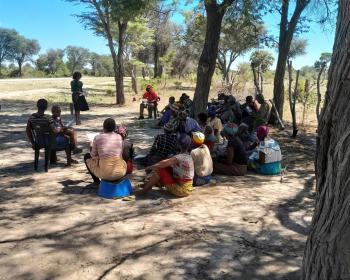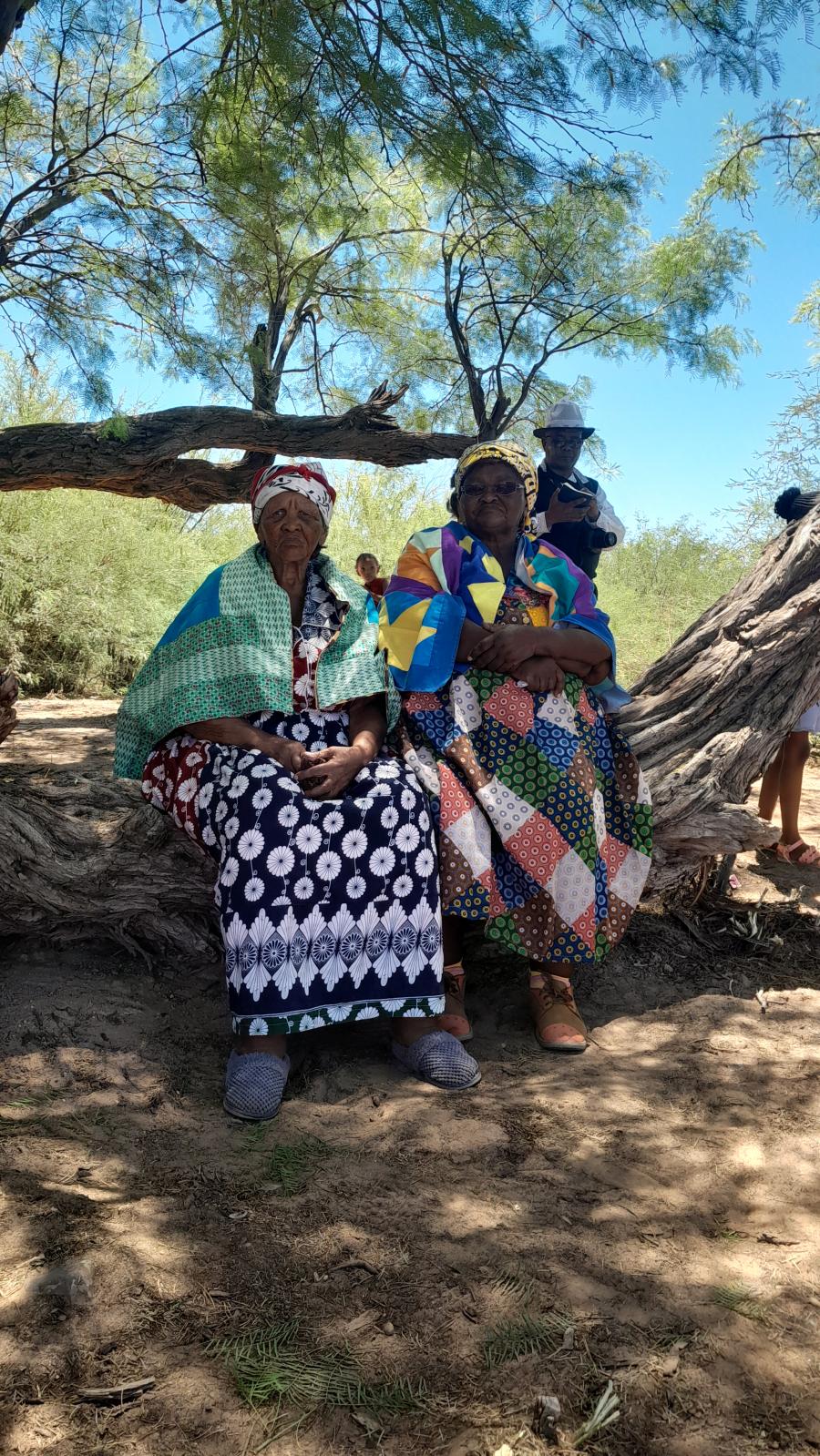An examination of the Ju/Wasi San in the eastern Bushmanland area of northeastern Namibia back in 1980 would have revealed the grave problems faced by these people. Almost 1,000 people were crowded into a settlement at Tsum!kwe, an administrative center established by the South African government in 1960. The Ju/Wasi, as were many contemporary indigenous populations in modern nation-states, were poverty-stricken, malnourished and plagued by severe socio-economic difficulties. In general, their unemployment levels and infant mortality rates were high (in the case of the latter, alarmingly so) and their life expectancy was low.
The extent of social conflicts endemic to Tsum!kwe is revealed in John Marshall's heart-wrenching 1978 film N!ai: the Story of a !King Woman. In addition to hunger, Ju/Wasi were beset by social conflict. Most people were no longer going to the bush for food, and even those few individuals who did forage found resources seriously depleted. Cash and welfare had become the major sources of subsistence and income by the late 1970s. Attempts to build up herds of livestock and to plant gardens were largely unsuccessful, due in part to environmental constraints and in part to pressure to share the results of food production efforts.
The Ju/Wasi faced another problem in 1980: the expansion of military activities and recruitment of San in Bushmanland by the South African Defence Force (SADF). A military base was established at Tsum!kwe in August 1978. Local San began to be recruited into a newly founded military unit known as Bushman Battalion 36. !Kung soldiers and their families, refugees from Angola, had been brought into the area, thus increasing population density levels and posing the threat of interethnic conflict. Arguments and fights soon became relatively commonplace at Tsum!kwe, exacerbated by high levels of alcohol consumption. As one Ju/Wa put, "Today there are too many people, too little food and much fighting."
The Ju/Wasi in 1980 could be seen as a generally unhealthy, apathetic and disillusioned group. Many of them depended on the Namibian government or the military for their very existence. As if this situation were not dire enough, in the early 1980s the government decided that eastern Bushmanland should be turned into a nature reserve in which tourism would be encouraged. This meant in essence that the only Namibian San left with a fragment of their land would by deprived of the rights to use that land as they chose. Foraging activities would be curtailed, and people would not be allowed to reside or keep livestock in reserve areas. Some people saw this decision as threatening the very survival of the Ju/Wasi.
By 1981, some Ju/Wasi groups began to relocate away from Tsum!kwe. Four different groups decided to return to their traditional n!ores (territories) and to engage in a mixed economy consisting of foraging, pastoralism, agriculture and wage labor, a trend that also has occurred among Aboriginal people in Australia.
As Volkman has noted, a common myth prevalent in southern Africa is that the Ju/Wasi and other San are hunter-gatherers by nature, making them incapable of engaging in alternative kinds of economic activities with any success. The decision of some Ju/Wasi to leave the Tsum!kwe settlement underscores the fact that many of these people do wish to develop themselves and become economically self-sufficient.
These self-help and development efforts have been supported in part by a rural development project initiated not long after the departure of the first groups from Tsum!kwe. What began in 1981 as a cattle fund, designed to assist in establishing herds of stock for Ju/Wasi communities, has grown into a large-scale, multifaceted development effort. The Ju/Wasi play a significant part in decision making with regard to development initiatives under this project.
The Ju/Wa Bushman Rural Development Project, as it has come to be known, is an activity supported by the !King San Foundation, a foundation affiliated with Cultural Survival. The objectives of the project in eastern Bushmanland include (1) to establish communities in which Ju/Wasi can pursue a mixed economic strategy and (2) to promote self-help, self-determination and local control over land. The Ju/Wa Bushman Rural Development began supporting Ju/Wa groups by providing technical assistance, tools, equipment, pumps and livestock purchased at subsidized prices. Setting up these settlements is crucial to the survival of the Ju/Wasi people, who otherwise face the prospect of further dispossession and impoverishment.
A particularly important aspect of the self-help efforts in eastern Bushmanland is the emphasis on human resource development. In 1986 the Ju/Wasi formed their own farmers union to serve as a focal point for discussions about development planning for their area. At the meetings of the Ju/Wa Farmers Union, members review applications for the establishment of new communities, discuss issues such as livestock distribution and outline new development strategies.
A number of environmental and political-economic constraints hinder development of people in the northern Kalahari Desert. The area in which the Ju/Wasi reside is semi-arid, marked by gently undulating sandy plains covered with tree-bush savanna. Drought is a recurrent phenomenon in the Kalahari, and northeastern Namibia has had a dearth of rain for the past seven years. Access to water obviously is crucial to the adaptive success of any population in this area. Another problem that the Ju/Wa Farmers Union has addressed is predator control, a vexing issue given the fact that people face the possibility of being arrested for killing the lions that destroy their cattle.
One political-economic constraint that the Ju/Wasi face is the uncertainty of the land tenure status of the area. The immediate threat of forming a nature reserve in the area has been alleviated for the moment, but plans are still under way to expand wildlife numbers through provision of water points and to increase tourism. The new water points in the region, combined with the ongoing conflict in Angola which drives game down from the north, have led to a tremendous increase in the elephant population in eastern Bushmanland. Seeking moisture, elephants tend to destroy borehole pumps, troughs and other water-related infrastructure. This has required such intricate measures as stringing up electric fences and piling large mounds of boulders around water points to keep elephants away.
One way in which eastern Bushmanland differs from other parts of the Kalahari in which Ju/Wasi reside, such as the Dobe area of northwestern Botswana, is that the land is reserved solely for local Ju/Wa populations. This may not be the case for long, however. Settlers have been at/Gam in the southern part of the Nyae region since January 1987, and talk has been circulating of other groups of "Bushmen" being allowed into the area as well. One reason for the pressure for resettlement on the part of Ju/Wasi is that strategy may help curb the threat of their land being usurped by other groups.
Land and Livestock Development
In many ways, the Ju/Wa Bushman Rural Development Project serves as a model for grassroots, bottom-up, participatory development. With project assistance, the Ju/Wasi have made remarkable progress toward becoming socially and economically self-sufficient. As of October 1987, a total of 10 communities had been established in the Nyae Nyae area. As the table indicates, each of these communities has a herd of livestock, with numbers ranging from 15 to 77. The average herd size, 37, is above the minimum level necessary to be viable in the Kalahari ecosystem. Most of the locations have a functioning water source; many of the Ju/Wa groups have constructed cattle kraals. Six of the communities are active in gardening and have planted melons, beans and other crops. The Ju/Wasi are also generating income through various methods, with a particular emphasis on handicraft production.
The Ju/Wasi gain valuable experience by running their own affairs. Not only do they control their own type of cooperative organization, but they also participate actively in complex aspects of livestock and land management. Weight gain of stock and calving percentages indicate that the Ju/Wasi of Nyae Nyae are becoming relatively successful pastoral producers. Income levels of some of livestock and livestock products. The diet of the Ju/Wasi in the new settlements is much better than it was at Tsum!kwe, particularly with the greater percentages of milk and bush foods.
In some ways, livestock production is crucial to the future adaptive success of the Nyae Nyae Ju/Wasi. Resource availability and population density levels are such that full-time foraging no longer is a viable alternative for local people. Investment in livestock promises significant economic returns. Foraging generally is not viewed as a legitimate form of land use, a fact that prevents hunter-gatherers from making claims to land for that purpose. Pastoralism, on the other hand, is accepted as an economical form of land use by the Namibian government and thus enables livestock owners to claim title to grazing land.
Land is the most important means of production in the Kalahari and is the key to survival of Ju/Wasi and other peoples. Eastern Bushmanland is one of the few areas in Namibia in which San can gain access to grazing and arable land of sufficient quality in order to sustain communities over the long term. One crucial issue remains, however: whether the increasing numbers of livestock in the region will exceed the carrying capacity, which would lead to overgrazing and environmental degradation. This is not a problem for the moment, since the livestock numbers in the region are still relatively low.
The question of commercialization of livestock production among the Ju/Wasi is an interesting one. Gordon claims that the San do not want to become involved in commercial ranching. My own interviews with Ju/Wasi, on the other hand, indicate that at least some of them would like to have substantial herds and to have high off take rates in order to generate income. In comparison to Ju/Wasi and other San in Botswana, the Nyae Nyae Ju/Wasi are relatively well-to-do in terms of their numbers of livestock.
The development of commercial farming in the area is at present constrained, however, by the "Red Line", a veterinary cordon used to control stock disease (not to prevent guerrilla incursion). The Red Line cuts off the communal areas of the north and east from the country's commercial (mostly white-controlled) farmland. Meat cannot be sold and cattle cannot be moved south of this line. Until it is lifted or at least pushed back, Ju/Wa cattle farming will remain on a subsistence level (apart from local sale.).
Conclusions
The Ju/Wa Bushman Rural Development Project is a superb example of participatory development. A substantial number of Ju/Wasi have begun to engage in a wide range of development and self-help-activities. Production levels, income and nutrition standards are on the rise in the settlements. Although it is too early to judge the success of the project by using such "development indicators" as reduction in infant mortality rates and rising literacy levels, on an impressionistic level the new communities do appear to have a higher standard of living.
There is no question about the increased self-confidence of many Ju/Wasi. Interview data suggest that many of them are very happy to be in the new settlements and away from Tusm!kwe, a locality they consider to be "a place of death". Overall, the Ju/Wasi are much more hopeful about the future than they were five years ago. The crucial variable in this process has been the willingness of the people of eastern Bushmanland to engage in self-help activities.
Article copyright Cultural Survival, Inc.


